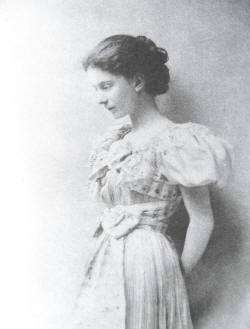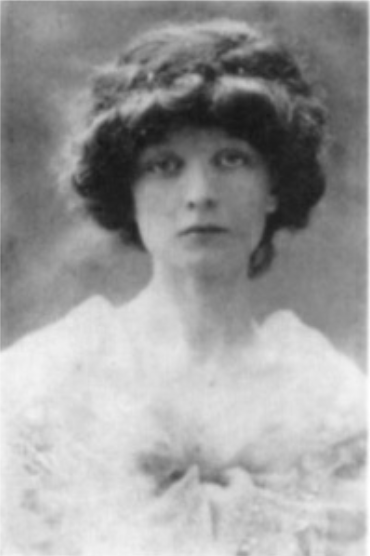

Partner Virginia Greer Yardley, Natalie Barney, Mary Hambidge
Queer Places:
Miss Porter’s School, 60 Main St, Farmington, CT 06032
Bryn Mawr College (Seven Sisters), 101 N Merion Ave, Bryn Mawr, PA 19010
4 Rue Chalgrin, 75116 Paris, Francia
Silkelianos Museum, Delfi 330 54, Grecia
 Evelina "Eva" Palmer-Sikelianos (January 9, 1874 – June 4, 1952) was an
American woman notable for her study and promotion of Classical Greek culture,
weaving, theater, choral dance and music. Palmer's life and artistic endeavors
intersected with numerous noteworthy artists throughout her life. She was both
inspired by or inspired the likes of dancers
Isadora Duncan and
Ted Shawn, the French literary great
Colette, the poet and author
Natalie Barney and the actress
Sarah Bernhardt.
She would go on to marry Angelos Sikelianos, a Greek poet and playwright.
Together they organized a revival of the Delphic Festival in Delphi, Greece.
Embodied in these festivals of art, music and theater she hoped to promote a
balanced sense of enlightenment that would further the goals of peace and
harmony in Greece and beyond.
Evelina "Eva" Palmer-Sikelianos (January 9, 1874 – June 4, 1952) was an
American woman notable for her study and promotion of Classical Greek culture,
weaving, theater, choral dance and music. Palmer's life and artistic endeavors
intersected with numerous noteworthy artists throughout her life. She was both
inspired by or inspired the likes of dancers
Isadora Duncan and
Ted Shawn, the French literary great
Colette, the poet and author
Natalie Barney and the actress
Sarah Bernhardt.
She would go on to marry Angelos Sikelianos, a Greek poet and playwright.
Together they organized a revival of the Delphic Festival in Delphi, Greece.
Embodied in these festivals of art, music and theater she hoped to promote a
balanced sense of enlightenment that would further the goals of peace and
harmony in Greece and beyond.
She was born into a wealthy New York family. Her father, Courtlandt Palmer, a freethinker trained at Columbia Law School, was from the Palmers of Stonington, Connecticut and her mother, Catherine, a musician, from the Amory family of Boston. Home-schooled among artistic luminaries and business scions, she boarded at Miss Porter’s School in Farmington, Connecticut after her father’s sudden death in 1888. She studied Greek and Latin at Bryn Mawr College. Palmer embraced the contradictory directions given to her by Bryn Mawr College. Though no stellar student, she gained enough training in classical languages to understand the significance of gendered adjectival endings and pronouns (lost in English translation) and to recite Sappho’s poetry in ancient Greek. Then, following M. Carey Thomas’s line of argument, she made use of classical prototypes to invert social conventions. She was likely practicing some form of “inversion” in the sexual sense in her dormitory room in Radnor Hall in the spring of 1898—perhaps testing Sappho’s words of love on a fellow student. At least one female classmate, Virginia Greer Yardley, recalled having a devastating “crush on Eva Palmer” and remained emotionally attached to her for years. In any case, Eva was caught doing something strictly prohibited, and President Thomas wrote her a stern letter “[forbidding her] the right of residence in the halls of Bryn Mawr College for one year from the 28th of May, 1898, to the 28th of May, 1899.” Yardley was a woman of class who inherited no wealth, but was the most attentive of Eva's lovers to issue of money and class as they influenced relations in their group. She maintained a painfully beautiful correspondence with both Palmer than Mary Gwinn Hodder.

Throughout her life, Eva was a non-conformist. She seduced Natalie Clifford Barney in Bar Harbor and followed her to Paris in the early 1900s. They aimed to create a woman-centered utopia reviving the spirit of Sappho’s Lesbos. Willful anachronism was part of their artistic practice. Eva, immersed in theatricality and Greek sources, devised the hairstyles, dress, music, gestures, scenery, and props for Barney’s performances that played with gender ambiguity.
She pursued another Greek-inspired utopia in Greece when her tempestuous relationship with Barney became unbearable. Dressed in sandals and a tunic she wove for one of Barney’s plays, she traveled to Greece with Raymond Duncan (brother of dancer Isadora) and his wife Penelope in 1906. She met Penelope’s brother Angelos Sikelianos. They married and settled in Greece the next year, giving birth to a son, Glafkos, in 1909. For 25 years, she promoted endangered musical practices, weaving, and handicrafts as forms of resistance to economic domination by the West. With Sikelianos as the public face of the events, she produced and directed two festivals of drama and games in 1927 and 1930 in the archaeological site of Delphi, spending all her money. The Delphic Festivals—expressions of an international modernist Hellenism grounded in the Greek present— used modern Greek expressive means to signal their Greece’s transhistorical survival. They helped popularize the performance of Greek drama in ancient sites in Greece and across the Mediterranean.
Now deeply in debt, Eva returned to the U.S. in 1933 to raise cash. She directed Greek plays and wove costumes to keep a roof over her head. The struggle to survive broke her health but not her spirit. By the mid-1940s, British and American interference in Greece’s internal affairs had radicalized her politically. She wrote over a thousand letters to politicians and newspaper in protest of American imperialism. The House Un-American Activities Committee listed her name four times on suspicion of campaigning to “disarm and defeat the United States.”
Though denied a visa to return to Greece in 1951, she did eventually return in the spring of 1952 to attend the third Delphic revival, a small festival of drama and part of the “Return to Greece” postwar tourist campaign supported by the American Marshall Plan. There she witnessed her vision for a Greek revival deployed by Greek and American officials to transform Greece into a tourist destination, something she strongly opposed. She suffered a stroke on site and lies buried in the village cemetery of Delphi.
Sara Bernhardt, Colette, Marguerite Moreno, and Isadora and Raymond Duncan are some of the people she worked with the first decade in Paris. Mrs. Patrick Campbell offered her acting work on the condition that she cut her ties with Barney, but she wouldn’t. George Cram Cook, Susan Glaspell, photographer Nelly Sougioutzoglou-Seraidare, filmmaker Dimitris Gaziadis, artist Yannis Tsarouchis, Koula Pratsika, an important figure in Greek dance history, and Aliki Diplarakou Lady Russell, who won the Miss Europe contest in 1930, were part of the Delphi scene. In the U.S., Eugene O’Neill supervised her work on the Federal Theater Project. Artist Katherine Dreier introduced her to Ted Shawn. She corresponded with Paul Robeson and W.E.B. DuBois on politics and asked Robeson to play Prometheus in a performance she never staged in Delphi. She was the teacher, friend, and possibly lover of Mary Hambidge, weaver and founder of the Hambidge Center craft community in Georgia, who gave her shelter in the 1930s and 1940s. Greek folklorist Angeliki Hatzimihali was also a dear friend.
She had many connections in the music world. Soprano Emma Calve and harpsichordist Wanda Landowska were possibly her lovers. Natalie Curtis Berlin, a pianist who collected Native American music, was a family friend. She collaborated with Psachos, Greece’s first professor of Byzantine music, and Greek musicologist Simon Karas. Dimitris Mitropoulos stayed in her house near Corinth in 1924 composing music for Angelos’s poetry, and Richard Strauss and his architect Michael Rosenhauer visited her in Delphi two years later while planning to build a music hall on Philopappos Hill in Athens.
Her literary connections begin with Oscar Wilde and continue with Barney, Lucie Delarue-Mardrus, Collette, and Renée Vivien. Playwright Constant Lounsbery and novelist Elsa Barker were longtime friends. In Greece she knew the most prominent writers of the twentieth century: Sikelianos, Kostis Palamas, Nikos Kazantzakis, Kostas Karyotakis, and George Seferis. She corresponded with translators Kimon Friar and Rae Dalven. With Henry Miller she nominated Sikelianos for the Nobel Prize.
She knew all the heads of archaeological schools and many classicists and archaeologists in addition to artists working in the margins of the discipline: Joan Jeffery Vanderopol, Georg von Pscehke, and Alison Frantz. Archaeologist Theodore Leslie Shear was her correspondent on Cold War political matters in the 1940s. Bryn Mawr College presidents, professors, and alumni were her acquaintances, lovers, or good friends, including president M. Carey Thomas, Lucy Donnelly, Virginia Yardley, and Edith Hamilton, popularizer of Greek literature and myths with whom she corresponded about Greek tragedy for over a decade.
My published books: